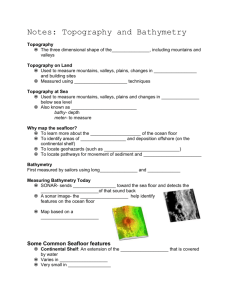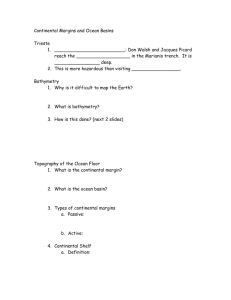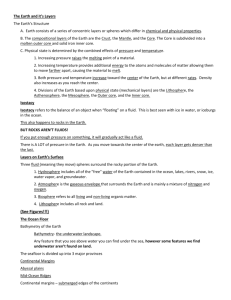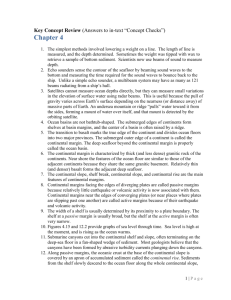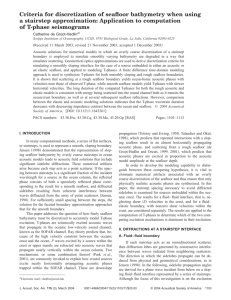Ch. 4: Continental Margins & Ocean Basins Lecture Notes Page
advertisement
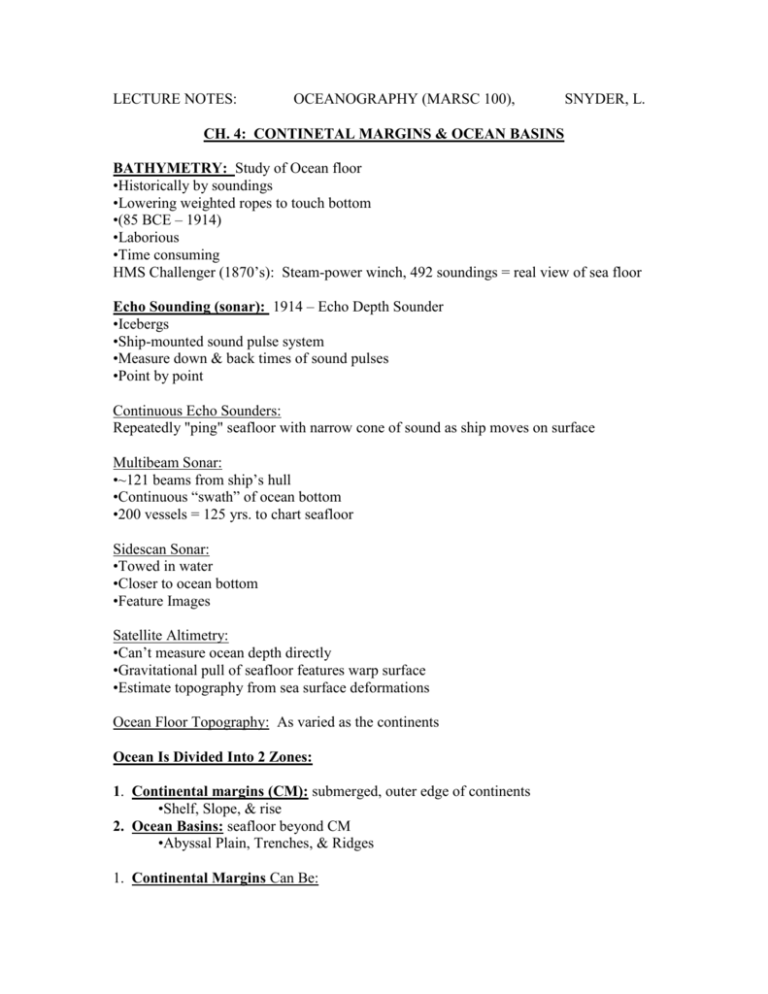
LECTURE NOTES: OCEANOGRAPHY (MARSC 100), SNYDER, L. CH. 4: CONTINETAL MARGINS & OCEAN BASINS BATHYMETRY: Study of Ocean floor •Historically by soundings •Lowering weighted ropes to touch bottom •(85 BCE – 1914) •Laborious •Time consuming HMS Challenger (1870’s): Steam-power winch, 492 soundings = real view of sea floor Echo Sounding (sonar): 1914 – Echo Depth Sounder •Icebergs •Ship-mounted sound pulse system •Measure down & back times of sound pulses •Point by point Continuous Echo Sounders: Repeatedly "ping" seafloor with narrow cone of sound as ship moves on surface Multibeam Sonar: •~121 beams from ship’s hull •Continuous “swath” of ocean bottom •200 vessels = 125 yrs. to chart seafloor Sidescan Sonar: •Towed in water •Closer to ocean bottom •Feature Images Satellite Altimetry: •Can’t measure ocean depth directly •Gravitational pull of seafloor features warp surface •Estimate topography from sea surface deformations Ocean Floor Topography: As varied as the continents Ocean Is Divided Into 2 Zones: 1. Continental margins (CM): submerged, outer edge of continents •Shelf, Slope, & rise 2. Ocean Basins: seafloor beyond CM •Abyssal Plain, Trenches, & Ridges 1. Continental Margins Can Be: •Passive (Atlantic): Divergent plate boundaries, few volcanoes & earthquakes •Active (Pacific): Convergent plate boundaries, many volcanoes & earthquakes Continental Margin Types: a. Continental Shelf: shallow, gently sloping extension of continents •Formed by continental erosion & sediment accumulation (river transport) •Wide at passive margins (up to 1280 km = 800 mi.)•Narrow at Active Margins (few km) b. Continental Slope: steeply sloping transition from shelf to ocean floor •Structurally part of continents •Average incline = 4° Submarine Canyons: Can cut into Continental Slope & Shelf •Earthquakes shake loose mass of sediment that plunges down shelf OR •Continuous small amount of debris erodes shelf (“turbidity current”): Continuous sediment cascade, Some fed by large rivers c. Continental Rise: accumulated sediment at base of continental slope • Created by: Turbidity current deposits at mouths of submarine canyons2. Deep-Ocean Basins: •Accumulated sediment (up to 5 km) over basaltic rock (5 km) •Variable topography Ocean Basin Features: a.Abyssal Plains: broad flat regions built by sediment deposition •Depth = 3,700 – 5,500 meters (2.5-3.6 mi.) •Covers seafloor basaltic rock •If lack a cover of sediments, expose small hills (Abyssal Hills): Formed by seafloor spreading•New crust (magma) coats hills •Usually < 200 m. (650 ft.) b.Seamounts: submerged volcanoes •Form at hotspots or spreading centers erosion)•Alone or in chains (10-100) •Guyot: flat-topped seamount (Wave c. Oceanic Ridges: mountain chain at active spreading centers (Diverging plates) •Where new oceanic lithosphere is made •Fracture zones (Transform Faults): occur where plate segments are offset= slide horizontally d.Hydrothermal Vents: Seafloor Hot spring •Continuously spews HOT (350°C = 660°F), mineral-rich water •Most at depths 2,100 m. (7,000 ft) •Areas of seafloor spreading (Mid-Ocean Ridges) •All seawater circulates through seafloor crust ~ 10 million yrs. •1st discovered (1977) in Alvin By Ballard & Grassle (Wood’s Hole OI) 1. Cold H2O seeps through seafloor cracks2. H2O is heated (350°) by molten rock below seafloor •Chemically reacts with minerals 3. Hot H2O & minerals rises to surface 4. Hydrothermal fluid exits chimney & mixes with cold seawater e. Ocean Trenches: Long, narrow, steep- sided depressions in deep seafloor •Occur where a converging plate is subducted •Deepest part of ocean •Many earthquakes & tsunamis originate in trenches •Hot rising magma creates volcanic island arcs (Japan) adjacent to trench Where are Oceanic Trenches? •Most occur in W. Pacific •Deepest spot in ocean: Challenger Deep (Marianas Trench):11,022 m (36,163 ft.) Deep Sea Research & Diving •Deeper you dive = more H2O is on top of you •Greater pressure on body •Weight of H2O above you: Hydrostatic Pressure •Like diving in deep end of swimming pool: feel Hydrostatic pressure against ear drums


